May 4 - 10, 2014: Issue 161
Cooper Sheep Shower Enamel Sign, Alfred Simpson and Sons of Adelaide and Collecting ‘Street Jewellery’ As Practical Art
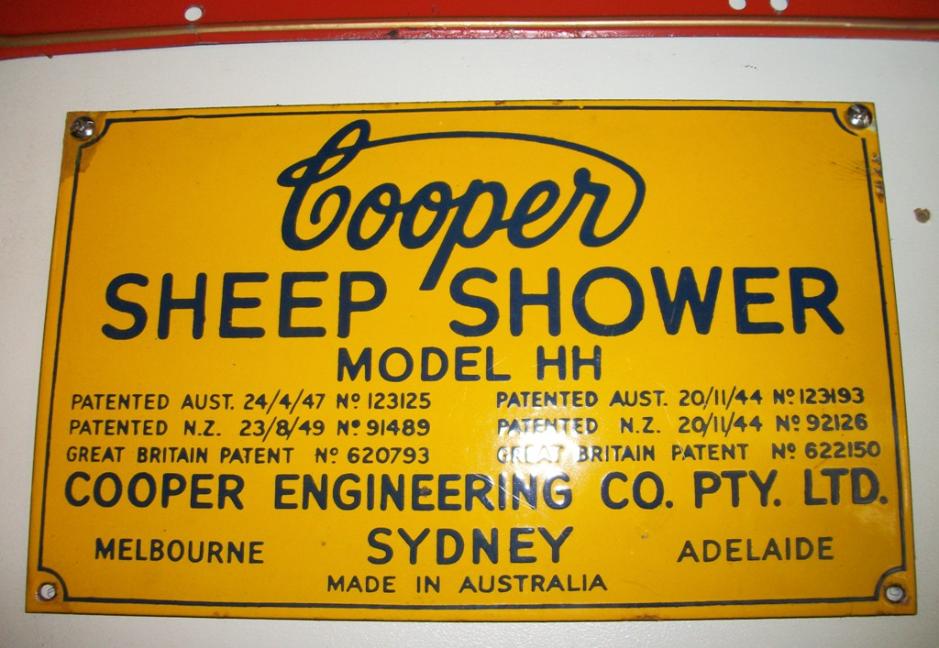
Cooper Sheep Shower Enamel Sign, Alfred Simpson and Sons of Adelaide and Collecting ‘Street Jewellery’ As Practical Art
Collecting old signs, especially the enamelled variety, has become popular as these items are not only colourful, they recall the youth of some collectors. There are antiques dealers who specialise in this field and are able to authenticate the original from the copy. As the prices for these are rising it is always worthwhile speaking to someone with experience in the field of any collectible, especially if you’re an avid collector and wish to cover a whole wall with what will be expensive items. The older or rarer versions will fetch higher prices, as will those in mint condition.
An enamel sign is a sign made using vitreous enamel. These were commonly used for advertising and street signage in the period 1880 to 1950. Benjamin Baugh created the first purpose-built factory for making such signs in Selly Oak, in south-west Birmingham, England in 1889 — the Patent Enamel Company.
Vitreous enamel is a thin layer of glass fused by heat to a metal surface. The word enamel comes from the German word ‘Smeltza’ and the French word ‘esmail’. Due to the durability of Enamel; hard wearing, scratch fine and chemical resistant, these signs can be seen over a hundred years later, with colours as bright and clear as when they were original made.
In Australia the making of enamel signs can be traced back to 1855, when Simpson’s of Adelaide opened an ironmongery which later diversified into enamel signs in 1898. Although there were certainly other manufacturers of enamel signs in Australia, this one is selected for this page due to the number of 'firsts' associated with this family listed under Extras (below) and the fact that they produced thousands of versions for just about every company in Australia.
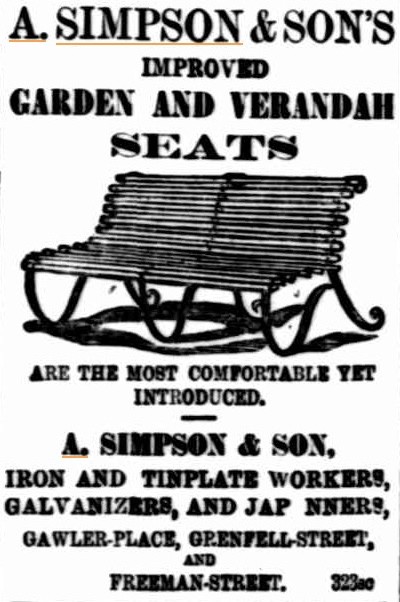 Advertising. (1876, December
30). South Australian Register (Adelaide, SA : 1839 - 1900), p. 3.
Retrieved from http://nla.gov.au/nla.news-article43014945
Advertising. (1876, December
30). South Australian Register (Adelaide, SA : 1839 - 1900), p. 3.
Retrieved from http://nla.gov.au/nla.news-article43014945
These colourful signs are not restricted to men’s shed’s and corner room bars – old advertisements for flours, flowers and garden implements make attractive additions to any cook’s kitchen but it is what they speak of that reinstates what has come before us and, for the curious, will spark an investigation into what they speak of, which is also another method of ensuring you are purchasing the authenticate item.
Another method employed by those who have studied this area is dating the enamel signs by their style and pattern. Lettering style is also an important dating tool, as strong variations have appeared through the years.
They were commissioned by the manufacturers themselves – some sources stating that much of our population prior to the 1900’s was illiterate but could recognise pictures and these were used. As we became more literate an attuned to our times themes became prevalent – Player’s Navy Cut cigarettes, as one example, featured the first World War ships the HMAS Hero and HMAS Invincible… not that anyone who spends their time out in deep sea breezes would condone filling their lungs with smoke!
Tomorrow’s auctions – Household 'Furniture, Enamel Signs, Alarm Clocks, etc.; at 183 Riley-steeet, off Oxford-street; at 11, by Hyam Hains. TO-MORROW'S AUCTIONS. (1903, April 30). Evening News(Sydney, NSW : 1869 - 1931), p. 6. Retrieved from http://nla.gov.au/nla.news-article113412538
The one shown here is from Trevor’s Museum, Avalon, and one of several from his collection – we choose this one as it harks back to the formative days of enamel signs in Australia.
A Cooper Sheep Shower enamel sign sold for $109.00 April 29th, 2014. but for those of you not familiar with farming methods – what is a ‘sheep shower’: it was a method of protecting sheep from external parasites that can harm them, known as ‘sheep dipping’ proior to the advent of a sheep shower.
MODERN METHOD OF DIPPING SHEEP. Views of the Cooper Sheep Shower in action on Mr. Green's property, Antill Ponds. The upper picture is a general view of the yards with showered sheep being released from the yard on the left while those on the right are still being sprayed. In the centre is a close up of the sheep in the shower while the lower picture shows the fine spray rising from the floor jets and the swinging spray dropping from above. -Kurrajong photos. MODERN METHOD OF DIPPING SHEEP. (1946, December 7).Examiner (Launceston, Tas. : 1900 - 1954), p. 10. Retrieved from http://nla.gov.au/nla.news-article96488321
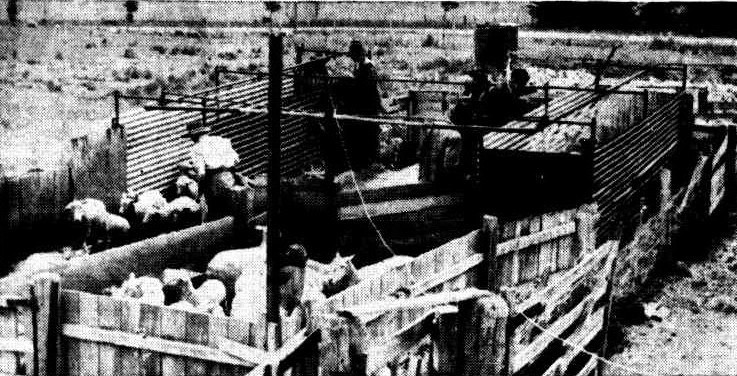
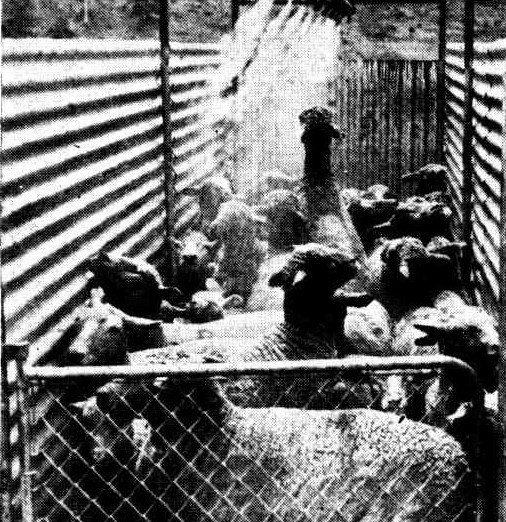
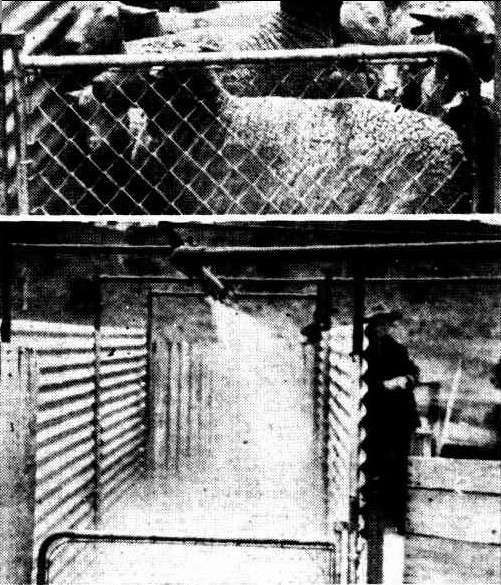
A working exhibit of the Cooper Sheep Shower, an improved method of controlling external parasites on sheep, will demonstrate its saving in manpower, amount of dip used, and sheep losses. Cooper shearing plants in portable and post types will also be on exhibition. The man on the land will find Alfred Harrap's stand full of interest. ALFRED HARRAP Pty. Ltd. (1949, October 8). Examiner(Launceston, Tas. : 1900 - 1954), p. 23 Section: The Examiner JUBILEE SHOW PREVIEW 1899-1949. Retrieved from http://nla.gov.au/nla.news-article52698980
The Cooper Engineering Company began in Australia around 1893 under Henry Harrowell. The family business originally known as "Coopers" was founded by William Cooper, a veterinary surgeon, circa 1843 in Berkhamstead, Hertfordshire (U.K.) who was frequently confronted by the horrendous condition of farm animals caused by various parasitic insects, in particular a skin disease which afflicted sheep known as "sheep scab" - at that time treated ineffectually by ointments composed of tobacco stalk and brimstone emulsified in animal fats. Mr. Cooper began to conduct his own experiments with preparations of arsenic and sulphur. By 1852 his experiments were conclusive enough for him to market the first truly effective sheep dip known as "Cooper's dip" it was sold in a powdered form which was easily transportable.
A CHANGE OF NAME. As we close for press we are informed that the business hitherto carried on by the Cooper Sheep Shearing Machine Proprietary, Ltd., has been purchased by Messrs. William Cooper and nephews, of Berkhamstead, England, the proprietors of 'Cooper's Dip,' and that, on and after the 1st July next, the business will be conducted by them at the same address, 10 Young-street, Circular Quay, under the designation of 'Cooper Engineering Company.' A CHANGE OF NAME. (1909, July 2). The Farmer and Settler(Sydney, NSW : 1906 - 1957), p. 10. Retrieved from http://nla.gov.au/nla.news-article115963175
The rise in use of Neon signs and Posters added to the demise of these wonderful practical artworks and now, they not only make colourful additions to corners of homes, they also are great as a way of maintaining a connection to where we have come from.
What is interesting to note is that in 2008 the consulting firm commissioned by Museum Victoria to update their signage chose vitreous enamel steel panels as a platform to display the museum’s entrance information as they are resistant to vandalism, attractive and long wearing, among other qualities. A ‘full circle’ and not all improvements are actually making things better story there!
CLAUDE NEON. Claude Neon Industries Ltd., which was formed last year to acquire the issued shares of Claude Neon Ltd. and Claude Neon Lights (Victoria) Ltd.. has declared an interim dividend of 5 per cent. The company has announced that sales of Neon signs for the half-year ended December 31 were buoyant and exceeded expectations. The company has 'extended its operations to the manufacture of porcelain enamel signs, and for this purpose has Installed new equipment. CLAUDE NEON. (1939, February 22). The Argus (Melbourne, Vic. : 1848 - 1957), p. 6. Retrieved from http://nla.gov.au/nla.news-article12100169
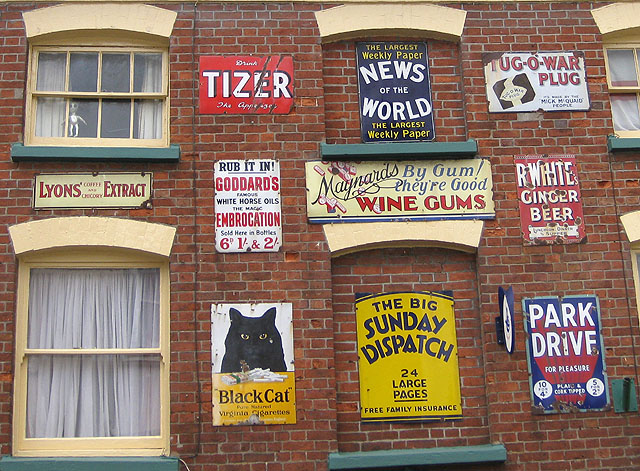
Selection of enamel signs Advertising a variety of life's comforts at the time
References:
Museum of Victoria Commissions Use of enamel signs 2008: http://www.heinejones.com.au/wp-content/uploads/2012/02/Immigration_Casestudy.pdf
Street jewellery: a history of enamel advertising signs / by Christopher Baglee & Andrew Morley. London : New Cavendish Books, 1978.
Olde Sydney Signs: http://www.oldsydneysigns.com.au/
Roadside Relics (Australia) : http://www.roadsiderelics.com.au/
Specialists in the fields of advertising items and enamel signs and examples of current prices (UK) : http://www.chippenhamauctionrooms.co.uk/advertising_antiques_and_enamel_signs.html
Mosaic and enamel signs in New York Subways: http://www.aiga.org/the-mostly-true-story-of-helvetica-and-the-new-york-city-subway/
Photo in text: Selection of enamel signs Advertising a variety of life's comforts at the time: newspapers, cigarettes, tobacco, wine gums, coffee and just in case, Goddard's Embrocation. How many have you heard of and how many are still on sale? (In Herefordshire, Great Britain). Photograph by Pauline Ecles.
Extras:
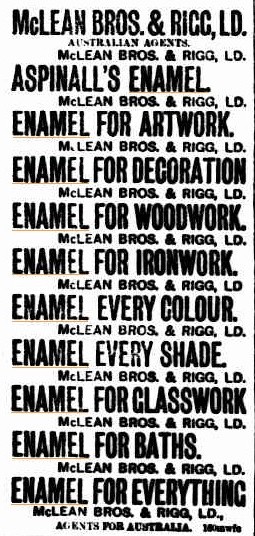 Advertising. (1890,
October 20). South Australian Register (Adelaide, SA : 1839 - 1900),
p. 3. Retrieved from http://nla.gov.au/nla.news-article47259163
Advertising. (1890,
October 20). South Australian Register (Adelaide, SA : 1839 - 1900),
p. 3. Retrieved from http://nla.gov.au/nla.news-article47259163
Alfred Simpson, born 1805 England, journeyed to South Australia, with his wife, son and two daughters arriving in South Australia in 1849. Simpson had completed an apprenticeship as a tinplate worker, but had not worked in the industry in England. After trying various occupations and a stint on the Victorian goldfields, he established himself as a tinsmith on premises in Topham Street in 1853.
Simpson manufactured many products for agricultural uses and, as agricultural industries became more established in South Australia, so his business, known as the 'Colonial Tinware Manufactory', expanded. By 1862, Simpson extended his premises, now in Gawler Place.
Simpson's son, Alfred Muller Simpson, joined the business in 1864 when he turned 21.
In the 1860s, Simpson began manufacturing safes, which became well-known for their ability to resist attempts to blow them open with dynamite.
In 1868 Simpson undertook a major expansion of the Gawler Place premises. Alfred M Simpson and his wife travelled to the Paris Exhibition of 1878 and brought back ideas for labour-saving factory machinery and for new products or methods of refining existing products. In the late 1880s A. Simpson and Son manufactured munitions and mines, when a war between the British Empire and Russia loomed.
At the time of Alfred Simpson's death in 1891, A. Simpson and Son had the largest metal manufacturing plant in Australia. New works were opened in Wakefield Street in 1894 and they eventually covered over three acres. From 1898, the company began enamel plating with porcelain and its reputation in the other colonies grew from this activity.
Alfred M. Simpson's sons, Alfred Allen (known as Allen) and Frederick Neighbour, joined the firm when they finished their schooling. The business incorporated 1910, with Alfred as chairman, and Allen and Frederick as directors.
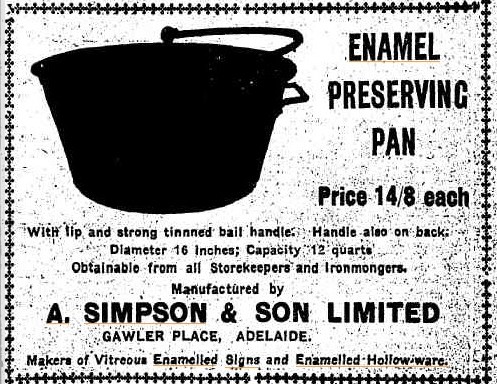 Allen was associated with the Royal Geographical Society of
Australasia over many years and when CT Madigan surveyed central Australia in
1929, the Simpson Desert was named in his honour. Cape Simpson in Antarctica is
also named for him as a result of his assistance to Douglas
Mawson.
Allen was associated with the Royal Geographical Society of
Australasia over many years and when CT Madigan surveyed central Australia in
1929, the Simpson Desert was named in his honour. Cape Simpson in Antarctica is
also named for him as a result of his assistance to Douglas
Mawson.
During the First World War, Simpsons returned to the manufacture of munitions and in the 1920s the company expanded further. A new factory was opened at Dudley Park in the 1940s and the company began the manufacture of whitegoods. In 1963 A. Simpson and Son merged with Pope Industries to form Simpson Pope Holdings. Alfred Simpson became chairman of the board of Simpson Pope Holdings. The Simpson brand, now owned by Electrolux, continues to produce a variety of household appliances.
Retrieved from State Library of South Australia at; http://www.samemory.sa.gov.au/site/page.cfm?u=1103
Advertising. (1918, April 30). The Register (Adelaide, SA : 1901 - 1929), p. 2. Retrieved from http://nla.gov.au/nla.news-article60347550
Alfred Muller Simpson:
A VALUED CITIZEN. MR. A. M. SIMPSON DEAD.
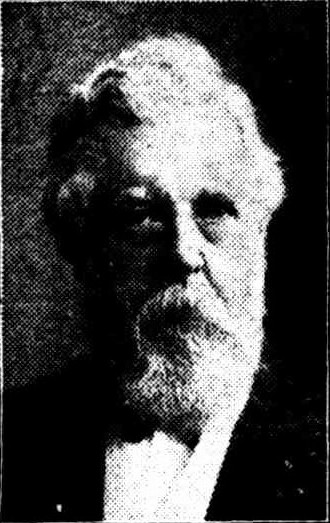 The tolling of the Adelaide Town Hall bell on September 28
gave to the citizens the sad news of the death of Mr.A. M. Simpson, head of the
well-known firm of A. Simpson & Son, hardwire manufacturers, which is
honorably knoivnall over the Commonwealth. Mr. Simpson, who was a very old
colonist, had been seriously ill for some time, and he underwent an operation
this week. He was born in London in 1843, but
he had lived nearly all his long and useful life in Adelaide. He succeeded his
father in the business with which he was so prominently and successfully
connected, but it was due to his energy and enterprise that it attained such
great proportions. Apart from his own business, Mr. Simpson was connected at
different times with the directorates of scores of companies, and his name on a
board was always taken to be a guarantee of soundness and stability. Mr.
Simpson came from London with his father, the late Mr. Alfred Simpson, by the ship John
Woodhall early in 1849, and the business in Gawler-place, Adelaide, was
established in 1853. It gradually developed into the largest concern of its kind
in the southern hemisphere. Mr. A. M. Simpson was educated at Mr. Martin's
academy in Pirie-street, and entered his father's business as an apprentice to
the tinsmith trade. He was an apt and industrious pupil, and steadily worked his
way through the various departments, until he was admitted into partnership. In
June, 1887, ne contested a seat in the Legislative Council for the Central
division. There were seven candidates, and Mr. Simpson was paid the compliment
of being returned at the head of the poll. After serving the electors faithfully
for six years he retired from Parliament, and . did not afterwards seek
re-election. The whole of his Parliamentary salary (£1,200) was Subsequently
devoted to founding the Simpson rifle trophy in connection with the military
defence forces. Throughout his career he did much to further the interests of
South Australia, and will be remembered as having taken a prominent part in the
promotion of the great Jubilee Exhibition at Adelaide in 1887. He was twice
president of the Royal Agricultural and Horticultural Society of South
Australia, and a member of the first committee of the Australian National
Union, the forerunner of the Australian Natives Association. He was an
honored Freemason, and was a Past Grand Master of the Grand Lodge of South
Australia. For a long period 'be filled the office of president of the board of
general purposes. Mr. Simpson became a trustee; of the State Bank of South
Australia In: 1902, and a member of the State Board! of Conciliation in 1902.
At a time when better transit facilities were badly needed by the residents
of the metropolitan area he rendered a public service as one of the promoters of
the Adelaide and Suburban Tramway Company, and on the foundation of the
enterprise in 1877 he was appointed; a director. It was the first horse tramway
system to be introduced in Australia, and prior to its installation Mr.
Simpson made a trip to America to gather necessary information. On the death of
Mr. W. C. Buik be became chairman of the company, and held that office until the
horse lines were sold to the Municipal Tramways Trust. It was Mr. Simpson who
received from the Price Government the famous cheque for £288,000 which was paid
to the private companies for their rights. For 27 years Mr. Simpson was on the
directorate of the South Australian Gas Company; for a long period he was
chairman, and his retirement in August, 1913, when he decided to curtail his
activities, was a severe wrench both to himself and the company. During the time
that he occupied a seat on the board rapid progress was made. When he was
elected the total revenue of the company was approximately £70,000, and he saw
it grow to £180,000 before he relinquished his enthusiastic part in the
management. His wise guidance was deemed to have had much to do with that
success. For some years he was chairman of directors of the Port Adelaide Dock
Company. Mr. Simpson was a generous member of the board for the Adelaide Botanic
Garden and among his public gifts were the central kiosk, which was erected at a
cost of £1,200, and the boy-and-swan fountain: As a philanthropist his kindness
of heart and his liberality, always of an unostentatious character, added to the
public esteem in which he was held. Among the institutions which owed much to
him were the Kalyra Consumptive Sanatorium, Estcourt House, and the South
Australian Blind, Deaf, and Dumb Institution (of which he became hon. Treasurer
in 1896). An instance of his patriotism and generosity was given last year,
when he presented between £2,000 and £3,000 to the Defence Department for the
purchase of Australia's first battle plane. The machine arrived in July last
from Great Britain and is at present in use at the Point Cook Aviation School.
Another public-spirited act was the gift, about 15 years ago, of the valuable
stained glass King Edward VII. windows in the Adelaide City Council Chambers.
Mr. Simpson was an ardent devotee of chess, and was president of the Adelaide
Chess Club. He was a prominent member of the Unitarian Church in
Wakefield-street. Mr. Simpson was twice married. By the first wife (formerly
Miss Catherine Allen) there were five children, of whom the elder son (Mr. A. A.
Simpson) is an ex-Mayor of Adelaide. The second son is Mr. Fred Simpson. Both
sons are directors of the firm of A. Simpson and Son. The father was still
chairman, but had practically disposed of his interest in the business some time
prior to his death. The daughters are Mrs. Owen Crompton, Mrs. L. C. Simpson
(who married a cousin and is living in England, her husband being a lieutenant
of artillery in the A.I.F.), and Miss Simpson. In 1887 Mr. Simpson was left a
widower. He married as his second wife Miss Violet L. Sheridan, daughter of the
late Dr. John Sheridan, of Edinburgh. For many years he had resided at Young
street, Parkside. No one was more widely known in the metropolis or more highly
honored than Mr. Simpson, either as a man or as a commercial magnate. A VALUED CITIZEN. (1917, October 6).
Chronicle (Adelaide, SA : 1895 - 1954), p. 13. Retrieved from http://nla.gov.au/nla.news-article87412768
The tolling of the Adelaide Town Hall bell on September 28
gave to the citizens the sad news of the death of Mr.A. M. Simpson, head of the
well-known firm of A. Simpson & Son, hardwire manufacturers, which is
honorably knoivnall over the Commonwealth. Mr. Simpson, who was a very old
colonist, had been seriously ill for some time, and he underwent an operation
this week. He was born in London in 1843, but
he had lived nearly all his long and useful life in Adelaide. He succeeded his
father in the business with which he was so prominently and successfully
connected, but it was due to his energy and enterprise that it attained such
great proportions. Apart from his own business, Mr. Simpson was connected at
different times with the directorates of scores of companies, and his name on a
board was always taken to be a guarantee of soundness and stability. Mr.
Simpson came from London with his father, the late Mr. Alfred Simpson, by the ship John
Woodhall early in 1849, and the business in Gawler-place, Adelaide, was
established in 1853. It gradually developed into the largest concern of its kind
in the southern hemisphere. Mr. A. M. Simpson was educated at Mr. Martin's
academy in Pirie-street, and entered his father's business as an apprentice to
the tinsmith trade. He was an apt and industrious pupil, and steadily worked his
way through the various departments, until he was admitted into partnership. In
June, 1887, ne contested a seat in the Legislative Council for the Central
division. There were seven candidates, and Mr. Simpson was paid the compliment
of being returned at the head of the poll. After serving the electors faithfully
for six years he retired from Parliament, and . did not afterwards seek
re-election. The whole of his Parliamentary salary (£1,200) was Subsequently
devoted to founding the Simpson rifle trophy in connection with the military
defence forces. Throughout his career he did much to further the interests of
South Australia, and will be remembered as having taken a prominent part in the
promotion of the great Jubilee Exhibition at Adelaide in 1887. He was twice
president of the Royal Agricultural and Horticultural Society of South
Australia, and a member of the first committee of the Australian National
Union, the forerunner of the Australian Natives Association. He was an
honored Freemason, and was a Past Grand Master of the Grand Lodge of South
Australia. For a long period 'be filled the office of president of the board of
general purposes. Mr. Simpson became a trustee; of the State Bank of South
Australia In: 1902, and a member of the State Board! of Conciliation in 1902.
At a time when better transit facilities were badly needed by the residents
of the metropolitan area he rendered a public service as one of the promoters of
the Adelaide and Suburban Tramway Company, and on the foundation of the
enterprise in 1877 he was appointed; a director. It was the first horse tramway
system to be introduced in Australia, and prior to its installation Mr.
Simpson made a trip to America to gather necessary information. On the death of
Mr. W. C. Buik be became chairman of the company, and held that office until the
horse lines were sold to the Municipal Tramways Trust. It was Mr. Simpson who
received from the Price Government the famous cheque for £288,000 which was paid
to the private companies for their rights. For 27 years Mr. Simpson was on the
directorate of the South Australian Gas Company; for a long period he was
chairman, and his retirement in August, 1913, when he decided to curtail his
activities, was a severe wrench both to himself and the company. During the time
that he occupied a seat on the board rapid progress was made. When he was
elected the total revenue of the company was approximately £70,000, and he saw
it grow to £180,000 before he relinquished his enthusiastic part in the
management. His wise guidance was deemed to have had much to do with that
success. For some years he was chairman of directors of the Port Adelaide Dock
Company. Mr. Simpson was a generous member of the board for the Adelaide Botanic
Garden and among his public gifts were the central kiosk, which was erected at a
cost of £1,200, and the boy-and-swan fountain: As a philanthropist his kindness
of heart and his liberality, always of an unostentatious character, added to the
public esteem in which he was held. Among the institutions which owed much to
him were the Kalyra Consumptive Sanatorium, Estcourt House, and the South
Australian Blind, Deaf, and Dumb Institution (of which he became hon. Treasurer
in 1896). An instance of his patriotism and generosity was given last year,
when he presented between £2,000 and £3,000 to the Defence Department for the
purchase of Australia's first battle plane. The machine arrived in July last
from Great Britain and is at present in use at the Point Cook Aviation School.
Another public-spirited act was the gift, about 15 years ago, of the valuable
stained glass King Edward VII. windows in the Adelaide City Council Chambers.
Mr. Simpson was an ardent devotee of chess, and was president of the Adelaide
Chess Club. He was a prominent member of the Unitarian Church in
Wakefield-street. Mr. Simpson was twice married. By the first wife (formerly
Miss Catherine Allen) there were five children, of whom the elder son (Mr. A. A.
Simpson) is an ex-Mayor of Adelaide. The second son is Mr. Fred Simpson. Both
sons are directors of the firm of A. Simpson and Son. The father was still
chairman, but had practically disposed of his interest in the business some time
prior to his death. The daughters are Mrs. Owen Crompton, Mrs. L. C. Simpson
(who married a cousin and is living in England, her husband being a lieutenant
of artillery in the A.I.F.), and Miss Simpson. In 1887 Mr. Simpson was left a
widower. He married as his second wife Miss Violet L. Sheridan, daughter of the
late Dr. John Sheridan, of Edinburgh. For many years he had resided at Young
street, Parkside. No one was more widely known in the metropolis or more highly
honored than Mr. Simpson, either as a man or as a commercial magnate. A VALUED CITIZEN. (1917, October 6).
Chronicle (Adelaide, SA : 1895 - 1954), p. 13. Retrieved from http://nla.gov.au/nla.news-article87412768
DEATH OF MR. A. A. SIMPSON. Former Mayor Of Adelaide LEADING ROLE IN BUSINESS LIFE
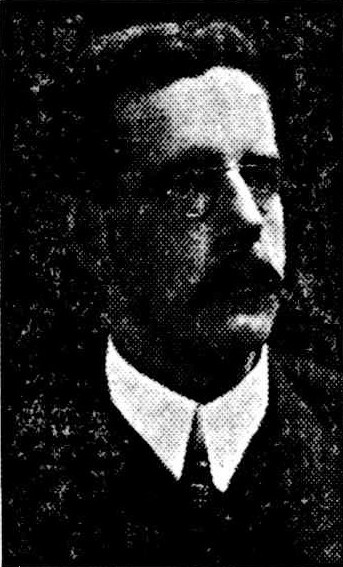 Mr. Alfred Allen Simpson, chairman of directors of
A. Simpson & Son, Ltd., and a former Mayor of Adelaide, died in a private
hospital at Adelaide late last night. He was 64. Although Mr. Simpson had not
taken a great part in public life in the past few years because of illness, he
was always public spirited, and up to 1936 held positions in numerous bodies
bound up with the welfare of the community. Mr. Simpson's last public activity
was to associate himself with the desert in Central Australia, which had already
been given his name by the Senior Lecturer in Geology at the University of
Adelaide (Dr. C. T. Madigan), in recognition of assistance given to his
exploration in the interior. At Mr. Simpson's request, Dr. Madigan recently led
an expedition to explore the desert. It was financed by Mr. Simpson, and his
son, Robert, acted as wireless operator. Born at Kent Town on April 15, 1875,
Mr. Simpson was the eldest son of the late Mr. Alfred Muller Simpson. He was
educated at Prince Alfred College and the University of Adelaide. He was made a
C. M.G. in 1919, and a C.B.E. in 1923. He was presented with the Medaille de Roi
Albert in 1921, and in 1930 was made a Knight of Grace of the Order of St. John
of Jerusalem.
Mr. Alfred Allen Simpson, chairman of directors of
A. Simpson & Son, Ltd., and a former Mayor of Adelaide, died in a private
hospital at Adelaide late last night. He was 64. Although Mr. Simpson had not
taken a great part in public life in the past few years because of illness, he
was always public spirited, and up to 1936 held positions in numerous bodies
bound up with the welfare of the community. Mr. Simpson's last public activity
was to associate himself with the desert in Central Australia, which had already
been given his name by the Senior Lecturer in Geology at the University of
Adelaide (Dr. C. T. Madigan), in recognition of assistance given to his
exploration in the interior. At Mr. Simpson's request, Dr. Madigan recently led
an expedition to explore the desert. It was financed by Mr. Simpson, and his
son, Robert, acted as wireless operator. Born at Kent Town on April 15, 1875,
Mr. Simpson was the eldest son of the late Mr. Alfred Muller Simpson. He was
educated at Prince Alfred College and the University of Adelaide. He was made a
C. M.G. in 1919, and a C.B.E. in 1923. He was presented with the Medaille de Roi
Albert in 1921, and in 1930 was made a Knight of Grace of the Order of St. John
of Jerusalem.
Patriotic Activities
Mr. Simpson became a member of the Adelaide City Council in 1901, and in 1904 was elected an alderman, a position which he occupied until 1913.For the succeeding two years he was Mayor of Adelaide. During the Great War be took a great interest in patriotic activities, and was chairman of the SJV. Soldiers' Fund, and the Patriotic Fund. In 1921 he was chairman of the Military Hospitals Advisory Committee, and was chairman of the Metropolitan County Board from 1908to 1910. Appointed an honorary commissioner, he reported on old age pensions in Europe in 1901, and in 1916on the introduction of new industries from America after the Great War. He was president of the Royal Geographical Society or Australasia from 1925 to 1930, and honorary treasurer of the Associated Chambers of Commerce of Australia from 1931 to 1932. He was president of the Adelaide Chamber of Commerce from 1933 to 1935, and a vice president of the Associated Chambers of Commerce of Australia from 1935 to 1936.In 1910. He was married to Miss Janet Doris Hubbe, daughter of the late Captain S. G. Hubbe. Mrs. Simpson survives, and there are six children. Misses Janet and Aubrey Simpson, and Messrs. Moxon, Robert. Frederick, and Donald Simpson. DEATH OF MR. A. A. SIMPSON. (1939, November 28). The Advertiser (Adelaide, SA : 1931 - 1954), p. 12. Retrieved from http://nla.gov.au/nla.news-article48852454
MR. A. A. SIMPSON, C.M.G. Mr. A. A. Simpson, C.M.G., is a prominent Adelaide citizen. He is Chairman of the South Australian Soldiers' Fund Committee, which has done invaluable services for soldiers and their dependants. He also came prominently before public notice as Mayor of Adelaide from 1913 to1915. He is a son of the late Mr. A. M. Simpson, and was born in South Australia 44 years ago. He was educated at MR. A. A. SIMPSON. C.M.G.
Prince Alfred College, on leaving which he joined the business of A. Simpson and Sons, Limited. He was first elected to the Adelaide City Council in 1901, and in 1904 he was returned as alderman. During his municipal career Mr. Simpson was Chairman of several important bodies, including the Metropolitan County Board. MR. A. A. SIMPSON, C.M.G. (1919, June 3). The Register(Adelaide, SA : 1901 - 1929), p. 8. Retrieved from http://nla.gov.au/nla.news-article62199979
The family business originally known as "Coopers" was founded by William Cooper, a veterinary surgeon, circa 1843 in Berkhamstead, Hertfordshire. As a veterinary surgeon he was frequently confronted by the horrendous condition of farm animals caused by various parasitic insects, in particular a skin disease which afflicted sheep known as "sheep scab" - at the time treated very ineffectually by only ointments composed of tobacco stalk and brimstone emulsified in animal fats. Cooper began to conduct his own experiments with preparations of arsenic and sulphur. By 1852 his experiments were conclusive enough for him to market the first truly effective sheep dip known as "Cooper's dip" it was sold in a powdered form which was easily transportable.
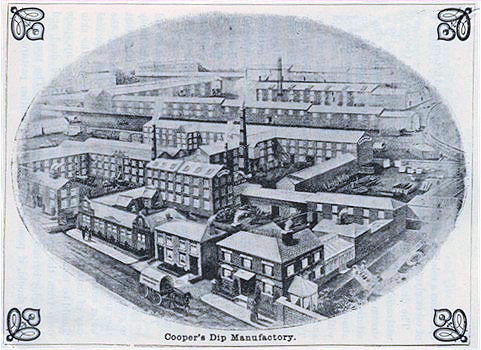 From 1852 throughout the remainder of the 19th century the
Berkhamstead based business expanded at considerable speed, the newly built
factory taking every advantage of the new mechanical innovations of the day. In
the 1860s the horses powered mills were replace with steam powered machinery.
The factory had its own printing press producing labels of a complicated design
in order to prevent the sheep dip being faked by the unscrupulous.
From 1852 throughout the remainder of the 19th century the
Berkhamstead based business expanded at considerable speed, the newly built
factory taking every advantage of the new mechanical innovations of the day. In
the 1860s the horses powered mills were replace with steam powered machinery.
The factory had its own printing press producing labels of a complicated design
in order to prevent the sheep dip being faked by the unscrupulous.
Cooper died in 1885 - he had been joined in the business by two nephews Henry Herbert Cooper who died in 1891 and Richard Powell Cooper. Richard Cooper on the death of his brother Henry became the sole proprietor of the business by now known as "Cooper & Nephews". It is from Richard Powell Cooper that the Cooper baronets are descended.
The Cooper Baronetcy, of Shenstone Court in Shenstone in the County of Stafford, was created in the Baronetage of the United Kingdom on 20 December 1905 for the agriculturalist Richard Powell Cooper.
The family business, in which the first four baronets were heavily involved, was notable for the invention of insecticides related to veterinary products, today known as Sheep dip. To date there have been six baronets. Sir William Cooper, 3rd baronet, once said "Our family solved Australia's economy overnight"
In terms of the British Baronetcy the Coopers are not an old family, their rise to prosperity during the Victorian era is a prime example of the achievement and social mobility possible in that age of scientific and industrial progress. When for the first time social advancement was occurring on a large scale. Cooper Baronets, of Shenstone Court. (2014, April 23). In Wikipedia, The Free Encyclopedia. Retrieved from http://en.wikipedia.org/w/index.php?title=Cooper_Baronets,_of_Shenstone_Court&oldid=605418920
William Cooper started manufacturing his arsenical sheep dip in Berkhamsted in the early 1850s and over the following 50 years its sales spread world-wide - at least to the many countries where sheep were farmed and sheep scab was a problem. Three nephews were involved. William Farmer Cooper joined the company in 1868 and was important in starting to develop the overseas markets. He died in 1882.Two other nephews, Herbert Cooper and Richard Powell Cooper, joined in 1880 and William Cooper died in 1885. The UK company had definitely taken the name "William Cooper & Nephews" by 1886, and I have found a 1882 trade directory entry which predates its use.
It seems that the company moved on to Australia in 1892, and was set up here under Henry Harrowell.
Richard Harrowell, of Oberon, NSW, Australia, writes: The Cooper's Henry Harrowell was born about 1847 in Epsom Surrey and was probably living in Bentley Heath, Solihull, Warwick just before he came to Australia to start Coopers here at the age of about 52. His family came with him, including teenagers Roland Henry Harrowell who later Managed Coopers in Australia, and Shirley Harrowell (Male) who later managed New Zealand. I know Roland travelled to the US to set up Coopers businesses there, but I don't have any details. Henry was married to Amelia (Carey I think) and lived most of his later life in New Zealand, before returning to Sydney shortly before he passed away in 1921. Retrieved from: http://www.hertfordshire-genealogy.co.uk/data/places/places-b/berkhamsted/berkhamsted-william-cooper.htm
HARROWELL.-November 16, at Arcadia, Galston, Reginald, youngest son of Mr. and Mrs. Henry Harrowell, Auckland, N.Z., aged 32 years (late of 7th Light Horse, A.I.F.). Family Notices. (1920, November 18). The Sydney Morning Herald (NSW : 1842 - 1954), p. 8. Retrieved from http://nla.gov.au/nla.news-article16875747
Our Albany correspondent nuder Sunday's date, telegraphs as follows:-The mail steamer from London arrived at 4 a.m. yesterday. Passengers for Albany : Mesdames Denny, Fortescue, Weeden, Cherril, and three children, Misses Weeden and Thing ; Messrs. Pearse, Waugh, Fortescue, McMeekan, Weeden (2), Johnson, Wall, Storey, Nesitt, Higginbotham, Swanfield, Potter, and Cberrill. Pafs-ngers outwards: Messrs. Harrowell, Bond, Blackbourne, Griggin, Gollan, Armitage, Shaw and Garrie. SHIPPING NOTES. (1892, November 19). Western Mail (Perth, WA : 1885 - 1954), p. 29. Retrieved from http://nla.gov.au/nla.news-article33076952
Researched and compiled by A J Guesdon, 2014.